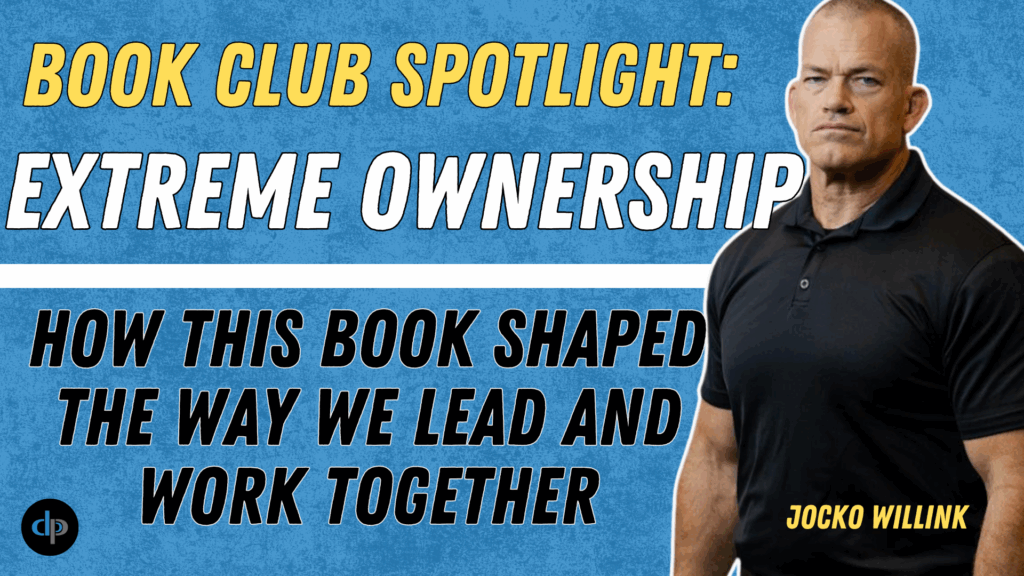
How Extreme Ownership Is Shaping the Way We Lead and Work Together
Every month, our team at Dentist Partner Pros gathers for a Book Club session. This isn’t just to check a box, but to reflect on how the principles we’re learning can actually apply to the real work we’re doing in recruiting, sales, operations, and client service.
This month’s spotlight is on a book that’s become something of a leadership classic: Extreme Ownership by Jocko Willink and Leif Babin. It’s direct, unapologetic, and full of real stories that force you to reflect on how you show up — not just in your work, but in your life.
In this recap, we’ll walk through the most meaningful takeaways from our team discussion and how those lessons are being put into practice inside a fast-moving agency like ours. We’ll also show how it might help you lead more effectively too, especially if you’re working with dental teams or running a private practice.
📌 Why Extreme Ownership?
Let’s start with the obvious: this isn’t a “soft” leadership book. The authors are Navy SEALs. The tone is intense. But what makes this book powerful is its simplicity. Each chapter starts with a battlefield story, transitions into a leadership principle, and ends with a business case study that connects it all.
More than anything, this book pushes you to take full ownership of your outcomes, regardless of how messy or complex the situation might be. For those of us in recruiting or managing client relationships, it’s a mindset shift that changes how we respond to breakdowns, delays, and missed expectations.
🔍 Chapter by Chapter: Our Team’s Takeaways
1. Cover and Move – Think Beyond Your Silo
This chapter sparked a powerful discussion for us. The principle here is that teams must work together across roles to accomplish a mission. It sounds obvious until you realize how easy it is to get hyperfocused on your own tasks and lose sight of the bigger picture.
We talked about how this shows up in our own world: sales promising deliverables that recruiting needs to fulfill, recruiters zeroing in on tasks without aligning with marketing, and how even small misalignments can create friction. The solution? Constant communication. Owning not just your task, but your role in the larger mission.
“The overall team fails, even if a specific member or element did their job successfully.”
That quote hit hard, especially for a team where roles are deeply interconnected.
2. Simple – Keep It Clear, Keep It Moving
Another favorite was the chapter on Simplicity. This was one of those chapters that got people nodding and cringing at the same time.
Whether it’s writing SOPs, drafting client updates, or onboarding a new recruiter, the temptation to over-complicate is always there. But as a team, we’ve started asking a better question: “What’s the actual goal, and what’s the simplest way to get there?”
The beauty of this principle is that it applies beyond business. Communication with clients. Internal documentation. Even parenting. If it’s not simple, it’s not clear. And if it’s not clear, it probably won’t get done right.
3. Prioritize and Execute – Manage the Chaos
This chapter brought out a spectrum of personalities on the team. Some of us thrive in high-pressure moments. Others feel overwhelmed and need structure to respond effectively. But regardless of our natural styles, the principle holds true: when everything feels urgent, you must stop, assess, prioritize, and then execute.
We each reflected on real moments like a recruiting crisis, a system outage, or a campaign falling flat and shared how we defaulted to either action or paralysis. The key? Don’t wait for perfect information. Make the best decision you can, act quickly, and adjust as you go.
“Decisiveness in uncertainty separates leaders from followers.”
For anyone in dental sales, marketing, or staffing, this is a muscle worth building. Chaos is inevitable. It’s how you respond that builds trust.
4. Leading Up and Down the Chain of Command
This one challenged our thinking the most. We often think about leadership in one direction: top-down. But what Extreme Ownership teaches is that you lead in all directions — up, down, and sideways.
That means it’s your job to make sure your team understands the mission. But it’s also your job to make sure your leaders have the information they need to make decisions. If there’s misalignment, assume responsibility. Get clarity. Communicate better. Lead from where you are.
“When things go wrong, stop pointing fingers. Take ownership. Fix it.”
In a high-growth agency or a private dental practice, this mindset can be the difference between chaos and culture.
💡 Our Biggest Takeaway: Discipline = Freedom
The final chapter left us with a paradox that stuck: discipline creates freedom. The more structure we create in our habits, planning, and execution, the more room we actually have to adapt, to think clearly, and to grow.
For us, that looks like:
- Clear KPIs, but not micromanagement
- Flexible work hours, but defined outcomes
- Freedom to solve problems, but strong accountability
This principle helps us lead better, trust more, and avoid the chaos that comes from unclear expectations.
👀 Why This Matters to You (Especially in Dental Services)
If you’re running a private dental practice, or supporting one through recruiting, sales, or marketing, the lessons from Extreme Ownership apply more than you think:
- Clear roles reduce staff friction
- Simplicity in systems builds efficiency
- Taking ownership creates trust with patients and partners
- Decisiveness keeps production on track
- Leading across roles helps teams act as one
In short, this isn’t just a book about military tactics. It’s a blueprint for building a culture where people take ownership, solve problems, and win together.
🔗 Want More?
If you’re looking for more book-based leadership takeaways like this, join our newsletter or follow us on LinkedIn. We’ll keep spotlighting ideas that help dental teams — and the people supporting them — do better, think clearer, and grow faster.